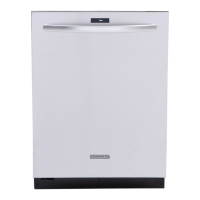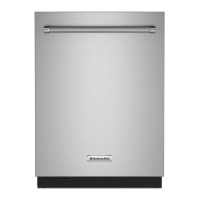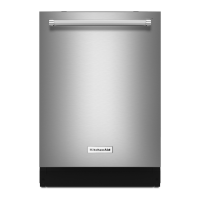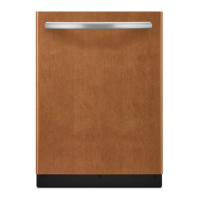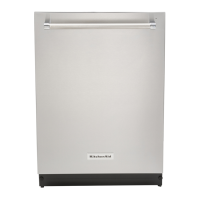1
FOR SERVICE TECHNICIAN’S USE ONLY
NOTE: This sheet contains important Technical Service Data.
W10758801A Tech Sheet Do Not Remove Or Destroy
Control Assembly
Meter Check of Loads and Fuses
Fuse Service Check:
F9 = Small-triac Load Fuse.
Check operation of loads during the Service Diagnostics cycle.
■ If any of the triac loads work, F9 Fuse is OK.
■ If all triac loads fail to work, F9 Fuse could be open. See “Fuse Resistance
Check.”
Fuse Resistance Check:
1. Unplug the dishwasher or disconnect power.
2. Measure resistance of F9 Fuse.
NOTE: Fuses are on the bottom of the Control Board but can be checked
from the top side. See “Control Pinout” diagram.
■ If resistance is < 3 Ω, then fuse is OK.
■
If resistance is > 3 Ω, then fuse is open.
What To Do If Fuse Open:
Inspect and check resistance of all loads on fuse. If any loads are open,
shorted, or have evidence of overheating or pinched wires, replace them.
DANGER
Electrical Shock Hazard
Only authorized technicians should perform diagnostic
voltage measurements.
After performing voltage measurements, disconnect
power before servicing.
Failure to follow these instructions can result in death
or electrical shock.
WARNING
Electrical Shock Hazard
Disconnect power before servicing.
Replace all parts and panels before operating.
Failure to do so can result in death or electrical shock.
SPECIFICATIONS
Electrical Supply:
(Under load) 60 Hz, 120 VAC
Lower Spray Arm Rotation:
12 to 40 rpm
Supply Water Flow Rate:
To fill 2 qt (1.9 L) in 27 seconds, 120 psi maximum, 20 psi minimum.
Upper Spray Arm Rotation:
12 to 30 rpm
Supply Water Temperature:
120°F (49°C) (Before starting a cycle, run water from sink faucet until hot.) REPAIR KITS
Water Charge:
1.0 gal. (3.9 L) Approximate
Vinyl Touch-up Kits:
675576 (Blue), 676453 (White), 676455 (Gray)
Voltage Measurement Safety Information
When performing live voltage measurements, you must do the following:
■ Verify the controls are in the off position so that the appliance does not start when energized.
■
Allow enough space to perform the voltage measurements without obstructions.
■
Keep other people a safe distance away from the appliance to prevent potential injury.
■ Always use the proper testing equipment.
■
After voltage measurements, always disconnect power before servicing.
4
Control Pinout
Meter Check of Loads and Fuses
Dishwasher Strip Circuits
The following individual circuits are for use in diagnoses. Do not continue with
the diagnosis of the appliance if a fuse is blown, a circuit breaker is tripped, or if
there is less than a 120-volt power supply at the wall outlet.
■ Unplug dishwasher or disconnect power.
■
Perform resistance checks. To check resistance of a component,
disconnect harness leads first.
Door Switch
Wash/Rinse
Water Heating/Heat Dry and Water Sensing with O.W.I. Sensor (Water/Air/Soil/Temperature)
Pump is washing. Control monitors temperature during water heating periods. See “Wash/Rinse” and “Water Sensing with O.W.I. Sensor (Water/Air/Soil/
Temperature)” circuits.
Fill

